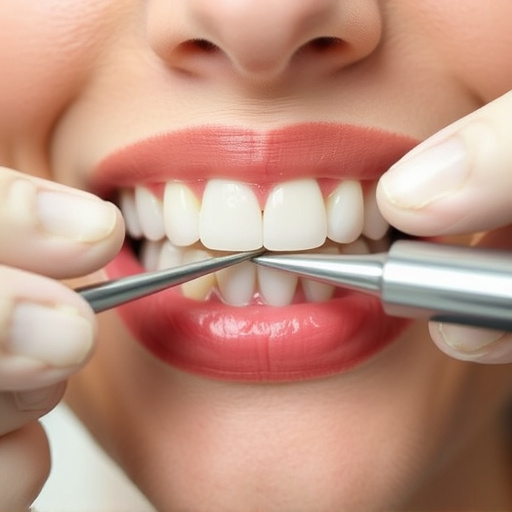Gum disease starts with gingivitis and progresses to periodontitis, damaging bone structures supporting teeth. Scaling and root planing, deep cleaning procedures, remove plaque and bacteria below the gumline, preventing further damage. Regular dental cleanings including these procedures enhance oral health and cosmetic outcomes by addressing weakened tooth structures. Initial assessment, scaling, root planing, and post-treatment care ensure effective gum health management.
“Gum disease, a silent yet serious oral health issue, affects millions. Understanding its impact on overall well-being is paramount. This article delves into effective gum therapy through scaling and root planing—a powerful duo in combating periodontal problems. We explore the science behind these procedures, their role in restoring mouth health, and provide a step-by-step guide for a successful treatment journey. Discover how this holistic approach can transform your oral care routine.”
- Understanding Gum Disease and Its Impact
- The Role of Scaling and Root Planing
- Step-by-Step Guide to Effective Therapy
Understanding Gum Disease and Its Impact

Gum disease is a prevalent oral health issue that often goes unnoticed until it reaches advanced stages. It begins with gingivitis, characterized by red, swollen gums and easy bleeding while brushing or flossing. If left untreated, gingivitis progresses to periodontitis, affecting not just the gums but also the bones supporting the teeth. This can lead to significant damage, including tooth loss, as the inflammation spreads throughout the mouth.
Scaling and root planing are effective treatments for gum disease. Scaling involves the meticulous removal of plaque, tartar, and bacteria from above and below the gumline, while root planing smooths and cleans the roots of teeth, promoting healthier gums. Regular dental cleanings, including these deep cleaning procedures, are essential components of comprehensive dental care, preventing further damage and ensuring a healthier smile. Even cosmetic fillings can become necessary if left unchecked, as gum disease weakens tooth structures.
The Role of Scaling and Root Planing

Scaling and root planing is a deep cleaning procedure that addresses the buildup of tartar and plaque below the gumline. This process involves two primary steps: scaling, where dental professionals remove the hardened plaque and tartar from above and below the gums, and root planing, which smooths and cleans the tooth roots to eliminate any rough spots that can trap bacteria. By eliminating these sources of infection, scaling and root planing helps to reduce gum inflammation and bleeding, promoting overall oral health.
This non-surgical procedure is often recommended as an effective alternative to invasive measures like tooth extractions, particularly for patients with gingivitis or early periodontitis. Unlike a routine teeth cleaning, which focuses on the visible surfaces of teeth, scaling and root planing targets the hard-to-reach areas where gum disease begins. Incorporating this into your cosmetic dentistry regimen can not only improve your smile’s appearance but also safeguard your oral health for years to come.
Step-by-Step Guide to Effective Therapy

Gum therapy is a comprehensive process that begins with a thorough understanding of your oral health needs. Here’s a step-by-step guide to effective scaling and root planing, a common gum therapy technique:
1. Initial Assessment: Start by consulting your dentist or hygienist. They’ll perform a detailed examination, including X-rays, to determine the extent of calculus (tartar) buildup and gum inflammation. This step is crucial for tailoring the treatment to your specific needs.
2. Teeth Cleaning (Scaling): Using specialized tools, the dental professional will carefully remove plaque and tartar both above and below the gumline. This process, known as scaling, is essential in preventing further gum disease progression. Advanced tools and techniques ensure thorough cleaning without damaging tooth enamel or roots.
3. Root Planing: After scaling, the dentist or hygienist moves on to root planing, which involves smoothing and shaping the root surfaces. This step promotes healing by removing irritants and creating an environment conducive to healthy gum attachment. Restorative dentistry techniques are utilized to ensure the procedure’s effectiveness and longevity.
4. Post-Treatment Care: Following the therapy session, your dental care provider will instruct you on maintaining proper oral hygiene, including brushing, flossing, and any recommended mouthwashes. Regular check-ups and professional cleanings, often every 3-6 months, are vital to sustaining the results of scaling and root planing. These visits ensure continued gum health and address any emerging issues promptly.
Scaling and root planing are proven, effective procedures for managing gum disease. By removing plaque and tartar buildup from below the gumline, this non-surgical treatment can revitalize oral health and prevent further damage. Incorporating regular scaling and root planing into your dental routine is a key step towards maintaining strong, healthy gums and a beautiful smile.














